
A much misunderstood set of units, the German Oasis Companies and their theoretically controlling Battalion Staff (BtlStab zbV 300).
On 10April 1941, a batch of Oasen companies were raised using men that had lived, or worked, in Africa. (Tessin lists the numbers 2, 6, 10, 12, 13, the numbers indicating the raising Wehrkreis, and that possibly 13 were raised, numbering 1 – 13). Also on 10.04.41, the Bataillonstab z.b.V. 300 was raised. It was a small staff consisting of about 10 officers to provide control for the Oasis companies. It was dissolved in 1942.
The Oasen companies occupied and guarded not only isolated oasis, but also wells, road junctions, etc., and were specially trained and equipped for water collection and treatment operations. Each infantry regiment in North Africa was supposed to have received one company in 1941. Five not so assigned were found directly under the DAK.
Controlled by BtlStab zvB 300, the companies were specially equipped and trained (for example, they could capture water vapor from the air to generate drinkable water). In the summer and early fall of 1941, each German infantry regiment in Africa received one Oasis Company. The remaining five companies (2, 6, 10, 12, 13) were put under direct DAK HQ control. The 300 Battalion Staff was just that, a staff of under 10 officers and men (no troops of its own) and it was absorbed by the DAK HQ staff in the fall of 1941. This staff was officially disbanded in mid-1942. All the Oasis Companies had limited motorization and no heavy weapons.
• 2-300 Oasis Co
• 6-300 Oasis Co
• 10-300 Oasis Co
• 12-300 Oasis Co
• 13-300 Oasis Co
Stab Divisions Kommando zbV Afrika
On 26 June 1941 the OKH had ordered the creation of the Stab Divisions Kommando zbV Afrika, which was formed in Germany by mid-July. However, since DAK’s requests of late July were rejected by the OKH, it was soon clear this HQ was not needed to create the motorized infantry division deemed necessary to support the other two. Therefore, it fell well down in the transportation list and was only sent to North Africa between late August and late September 1941, when it took over command in the Sollum area. The first units were attached on 15 October 1941, initially for training purposes only, and were III./IR 347 and Bataillon zbV 300 ‘Oasen’. Two weeks later 21.Panzer’s I./Schutzen Regiment 104 (temporarily subordinated to the Afrika Division itself) replaced it at Sollum. On 20 October more units, formerly corps troops, followed: Schutzen Regiment 155, III./IR 255, Pionier Bataillon 900 and Panzerjager Abteilung 605. Afrika Regiment 361 was also subordinated to the division. This unit, which was composed of former French Foreign Legion veterans (and was not considered completely reliable), had been formed in Germany on 15 June and arrived in North Africa between 20 October and mid-November. It was immediately deployed at Belhamed along with SR 155 while, at the same time, both III./IR 255 and III./IR 347 moved to Bardia to complete their training. At this point, Rommel decided that Afrika Division zbV (as it was known then) was to lead the planned attack against the fortress of Tobruk and ordered its redeployment to Bardia. On 2 November all the above-listed units (with the exception of Panzerjager Abteilung 605) were subordinated to the Stab Divisions Kommando zbV Afrika, followed a week later by the Stab and II Abteilung of AR 155, ll.(IG)/SR 104 and Aufklarungs Kompanie 580, all temporarily attached like I./SR 104. On 15 November 1941 Rommel ordered that Afrika Division zbV was to replace the Italian division ‘Bologna’ east of Tobruk and that all the units not yet in the Belhamed area had to be moved there by the 20th. Two days before, the British had launched Operation Crusader. Finally, on 28 November, the division was renamed 90.Leichte Afrika Division.
Heavy losses were suffered during Operation Crusader. As a consequence, some units were completely lost (III./IR 255, Bataillon zbV 300 ‘Oasen’ and I./SR 104, which surrendered at Sollum in January 1942), while others were badly mauled.
Sollum had been occupied by the Germans since November 21, 1941, and was now now defended by the 10th Oasis Company, the HQ of 300th Special Purpose Oasis Battalion, and the remnants of 12 Oasis Company.